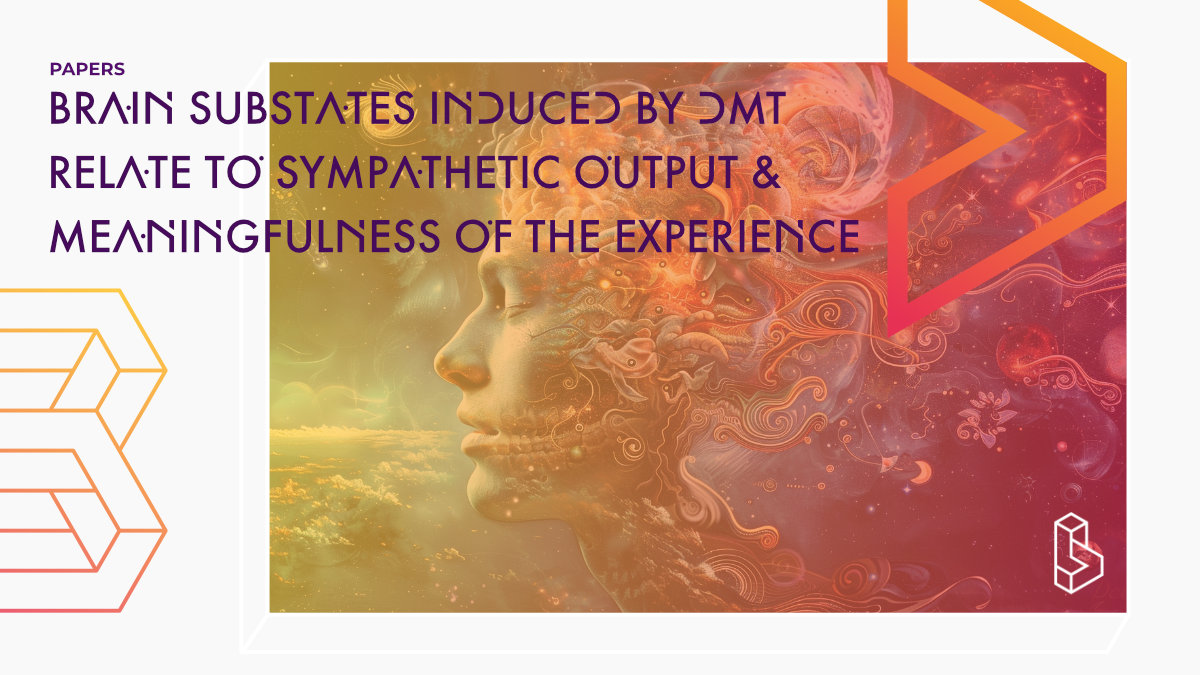This pre-print re-analysis of data from a single-blind study (n=14) used multimodal neuroimaging techniques (fMRI + EKG) to investigate brain activity and autonomic physiology during DMT (20mg) altered state of consciousness. Results reveal unique brain activity substates, with increased superior temporal lobe activity and hippocampal deactivation under DMT, correlating with auditory distortions and meaningfulness of the experience, respectively. Moreover, increased heart rate under DMT correlates with hippocampal and medial parietal deactivation, suggesting a potential link between sympathetic regulation and positive mental health outcomes following psychedelic administration.
Abstract of Brain substates induced by DMT relate to sympathetic output and meaningfulness of the experience
“N,N-Dimethyltryptamine (DMT) is a serotonergic psychedelic, known to rapidly induce short-lasting alterations in conscious experience, characterized by a profound and immersive sense of physical transcendence alongside rich and vivid auditory distortions and visual imagery. Multimodal neuroimaging data paired with dynamic analysis techniques offer a valuable approach for identifying unique signatures of brain activity – and linked autonomic physiology – naturally unfolding during the altered state of consciousness induced by DMT. We leveraged simultaneous fMRI and EKG data acquired in 14 healthy volunteers prior to, during, and after intravenous administration of DMT, and, separately, placebo. EKG data was used to derive continuous heart rate; fMRI data was preprocessed to derive individual dynamic activity matrices, reflecting the similarity of brain activity in time, and community detection algorithms were applied on these matrices to identify brain activity substates. We identified a brain substate occurring immediately after DMT injection, characterized by increased superior temporal lobe activity, and hippocampal and medial parietal deactivations under DMT. Superior temporal lobe hyperactivity correlated with the intensity of the auditory distortions, while hippocampus and medial parietal cortex hypoactivity correlated with scores of meaningfulness of the experience. During this first post-injection substate, increased heart rate under DMT correlated negatively with the meaningfulness of the experience and positively with hippocampus/medial parietal deactivation. These results suggest a chain of influence linking sympathetic regulation to hippocampal and medial parietal deactivations under DMT, which combined may contribute to positive mental health outcomes related to self-referential processing following psychedelic administration.”
Authors: Lorenzo Pasquini, Alexander J. Simon, Courtney L. Gallen, Hannes Kettner, Leor Roseman, Adam Gazzaley, Robin L. Carhart-Harris & Christopher Timmermann
Summary of Brain substates induced by DMT relate to sympathetic output and meaningfulness of the experience
Introduction
Bodily self-awareness is thought to result from the integration of visceral and autonomic bodily functions into a distributed brain network supporting homeostasis, interoception, and emotions, and the narrative self is thought to rely on a large-scale brain system associated with self-referential processes. DMT is a serotonergic psychedelic that rapidly induces an intense altered state of consciousness characterized by deep and profound immersion. This state typically lasts several minutes and gradually attenuates as participants regain normal waking consciousness approximately 20 min following the injection. DMT can cause changes in autonomic and central nervous system physiology, such as increased sympathetic tone and altered heart rate, which normalize as the effects of the drug dissipate. Studies using resting-state functional magnetic resonance imaging (rsfMRI) have shown that DMT results in global hyperconnectivity, collapsed hierarchical organization, and reduced intra-network integrity, particularly among core regions of the DMN. Further, dynamic analysis methods can be used to identify distinguishable physiological substates occurring during an entire scan.
Materials and Methods
Find this paper
Brain substates induced by DMT relate to sympathetic output and meaningfulness of the experience
https://doi.org/10.1101/2024.02.14.580356
Open Access | Google Scholar | Backup | 🕊
Cite this paper (APA)
Pasquini, L., Simon, A., Gallen, C., Kettner, H., Roseman, L., Gazzaley, A., ... & Timmermann, C. (2024). Brain substates induced by DMT relate to sympathetic output and meaningfulness of the experience. bioRxiv, 2024-02.
Study details
Compounds studied
DMT
Topics studied
Healthy Subjects
Neuroscience
Study characteristics
Original Re-analysis
Placebo-Controlled
Single-Blind
Within-Subject
Randomized
Re-analysis
Bio/Neuro
Participants
14
Humans
Institutes
Institutes associated with this publication
Imperial College LondonThe Centre for Psychedelic Research studies the action (in the brain) and clinical use of psychedelics, with a focus on depression.
Compound Details
The psychedelics given at which dose and how many times
DMT 20 mg | 1xLinked Research Papers
Notable research papers that build on or are influenced by this paper
Autonomic nervous system activity correlates with peak experiences induced by DMT and predicts increases in well-beingThis re-analysis of a single-blind study (n=17) investigates the role of the autonomic nervous system in DMT-induced peak experiences (20mg, iv). It finds that balanced activity between the "fight-or-flight" and "rest-and-digest" systems (sympathovagal coactivation) is linked to stronger feelings of spirituality and insight during DMT sessions and improved well-being two weeks later. The study also notes that a person's nervous system (sympathovagal) balance before taking DMT can predict how insightful their experience will be.
Network control energy reductions under DMT relate to serotonin receptors, signal diversity, and subjective experience
This re-analysis (n=14) applies a receptor-informed network control theory framework to investigate the effects of DMT on the brain's control energy landscape. It reveals that DMT, like LSD and psilocybin, reduces global control energy, with these trajectories correlating with EEG signal diversity and subjective intensity ratings. Furthermore, the regional effects of DMT correlate with serotonin 2a receptor density, demonstrating a potential proof-of-concept for predicting pharmacological intervention effects on brain dynamics using control models.
Human brain effects of DMT assessed via EEG-fMRI
This neuroimaging study (n=20) aimed to understand the effects of DMT (20mg) on the human brain. The researchers used EEG-fMRI (electroencephalography-functional MRI) to measure brain activity before, during, and after administering DMT to healthy volunteers. They found that DMT increased global functional connectivity (GFC), network disintegration and desegregation, and a compression of the principal cortical gradient.

